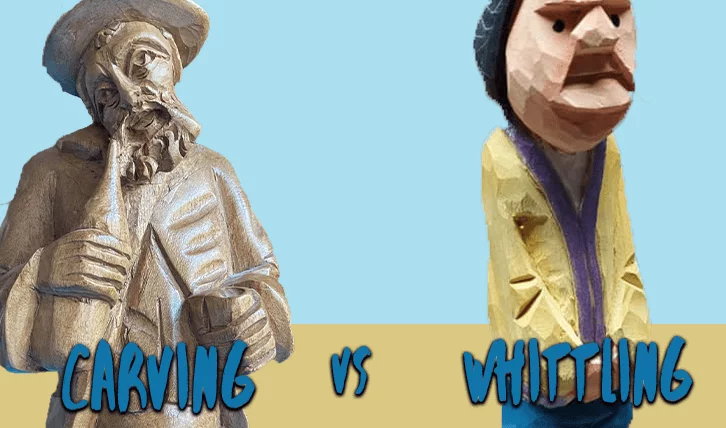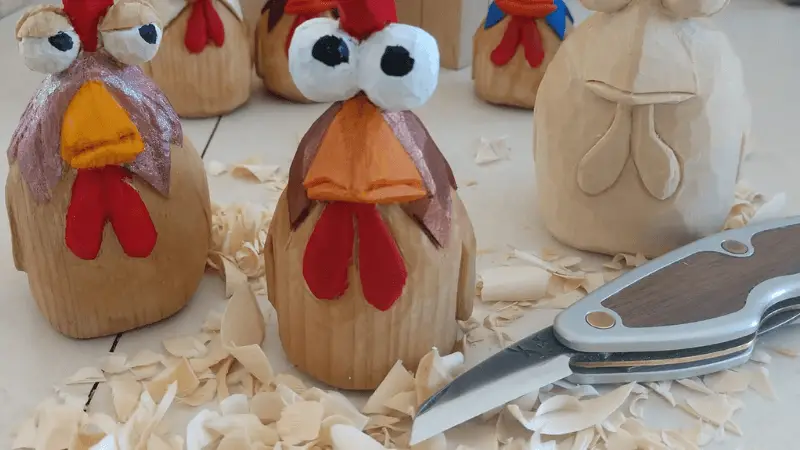Carving and whittling are two very similar processes that both fall under the umbrella of woodworking. The difference between carving vs whittling is subtle, but understanding it will help you choose which type of woodworking project you want to work on next!

What is wood carving?
Wood carving is a form of woodworking that involves the shaping and carving of wood using various tools and techniques. It is a skilled craft that has been practiced for centuries, resulting in intricate and detailed sculptures, decorative objects, furniture, and architectural elements.
Wood carving can be done using hand tools such as chisels, gouges, carving knives, and mallets, or power tools like rotary tools or carving machines. The choice of tools depends on the complexity of the project, the type of wood being used, and the desired outcome.
What is whittling
Whittling is a woodworking technique that involves shaping or carving wood by cutting thin slices or shavings from a piece of wood using a small, sharp knife. It is typically done by hand and often involves working with softer woods such as basswood, pine, or balsa.

Whittling is often seen as a leisurely and meditative activity, allowing individuals to create simple and functional items or express their creativity by carving decorative designs. Common whittling projects include figurines, animals, walking sticks, letter openers, and utensils like spoons or forks.
Carving vs Whittling
Carving and whittling, while sharing similarities, have distinct characteristics that set them apart as unique woodworking arts. Both involve the removal of wood to create sculptures or figurines, but understanding their differences can provide deeper insights into each craft. Let’s explore the key distinctions between carving and whittling
1. Carving vs Whittling: tools used
One of the key distinctions between carving and whittling lies in the tools used. Whittling embraces the simplicity of using only a knife as the main tool, allowing the artist to create with minimal equipment. The use of a single whittling knife not only emphasizes the art form’s essence but also imparts a distinct character to the final piece.

Carving, on the other hand, encompasses a wider range of tools, including chisels, mallets, and power tools. The use of chisels and mallets allows for greater control and precision when working with harder woods or creating more complex designs. Power tools, such as chainsaws or rotary tools, expand the possibilities of carving by enabling the sculpting of larger-scale pieces and the efficient removal of material.
The availability and use of various tools in carving make it suitable for both small and intricate projects as well as larger and more ambitious sculptures. The tool selection in carving reflects the versatility and adaptability of the craft to different scales and materials.
Read Next
- Wood Carving Tips for Beginners
- Can You Whittle with Any Knife?
- Best Woods for Carving Using a Dremel
- The Ultimate Beginner’s Guide to Woodcarving Gouges
- How to Prepare Wood for Carving
2. Difference by size
Size plays a significant role in distinguishing carving from whittling. Whittling typically involves creating smaller-scale pieces that can be held and manipulated by hand throughout the entire process. The use of a knife in whittling allows for intricate detailing and the creation of miniature sculptures, figurines, or functional objects.

In contrast, carving is not limited by size. The availability of a wider range of tools in carving allows for the shaping and removal of larger volumes of wood, enabling the creation of sculptures or objects of varying sizes. For smaller carving projects, special vices or clamps may be used to secure the piece in place, providing stability and precision during the carving process.
While whittling tends to be associated with smaller, hand-held items, carving encompasses a broader range of possibilities in terms of size and scale. This distinction leads some to consider whittling as a sub-category or specialized form of carving, with both practices offering unique opportunities for artistic expression.
3. Hobby vs professionalism
The distinction between carving and whittling as a profession versus a hobby is subjective and can vary from individual to individual. Some may consider carving to be more aligned with a professional pursuit, as it can be a means of livelihood for skilled artisans who make a living from their craft. However, it’s worth noting that hobbyists in carving can also produce high-quality work and even generate income from their creations without necessarily categorizing themselves as professionals.
Whittling, on the other hand, is often seen as a hobby or recreational activity enjoyed by individuals as a way to unwind and engage in a creative outlet. Many people whittle for personal enjoyment or share the experience with family members, using it as a means to relax and escape the demands of everyday life. While some may pursue whittling more seriously, it is generally perceived as a leisurely pursuit.
Ultimately, the distinction between carving and whittling in terms of profession or hobby is subjective and depends on the individual’s dedication, commitment, and how they perceive and prioritize their craft. The most important aspect is finding joy and fulfillment in the creative process, regardless of the label assigned to the activity. Whether one considers themselves a professional or a hobbyist, a wood carver or a whittler, the satisfaction derived from the art itself is what truly matters.
Whittling vs Carving: Recap
In conclusion, carving and whittling may share some similarities, but they have distinct characteristics that set them apart. Carvers utilize specialized hand tools like chisels and gouges, while whittlers rely on their knives as versatile tools for shaping wood. Understanding these differences can help deepen your appreciation for both crafts.
If you’re interested in delving deeper into the world of carving and whittling, we encourage you to explore our other articles. You’ll find detailed information about various techniques, helpful tips, and valuable tricks to enhance your skills and knowledge in these arts. We are continuously updating our content to provide valuable resources to our readers.
Moreover, we value your input and suggestions. If there are specific topics or distinctions you would like us to cover or explore further, please leave a comment at the bottom of any page on our website. Your feedback helps us tailor our content to meet your interests and needs.
Thank you for joining us on this journey of wood carving and whittling, and we look forward to continuing to provide you with valuable insights and inspiration. Happy carving and whittling!